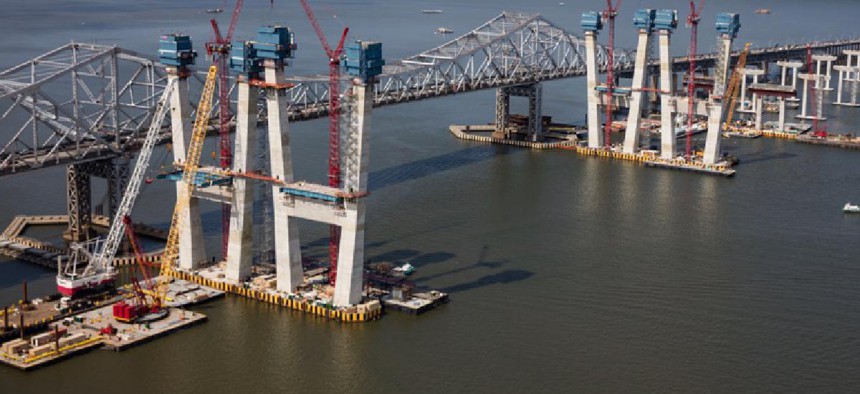Politics
Cuomo’s new state construction monitor draws mixed reviews

New York State Thruway Authority
The final version of a new state construction oversight agency will be a scaled-back version of Gov. Andrew Cuomo’s initial proposal. That much is clear.
What’s less clear is whether the changes to the agency, which is tasked with ensuring that major public works projects are completed on time and on budget, are actually improvements.
“It is not the new approach that most of us had hoped for that would have dealt with the chronic cost overruns and change orders that frustrate us on behalf of the taxpayers who feel the impact,” said Kathryn Wylde, president and CEO of the Partnership For New York City, a civic coalition of the city’s largest employers.
Under legislation passed this spring as part of Albany’s budget process, the state will create the New York State Design and Construction Corporation, a subsidiary of the Dormitory Authority of the State of New York, which already oversees well over a half billion dollars in public construction annually.
The DCC, which will be led by a three-member board appointed by the governor, will review public works projects worth at least $50 million that are undertaken by state agencies and independent authorities, like the Metropolitan Transportation Authority. Freeman Klopott, director of communications and marketing for DASNY, confirmed the creation of the new oversight body, but said that its “corporate structure is currently being designed.”
Critics like Wylde say the compromise legislation will result in an agency that is too watered down to do the job.
"The final version that was ultimately approved was defanged,” Wylde told City & State. “The changes took away the ability of the Design and Construction Corporation to originate and manage projects, or, if they felt an agency was not up to the task of successfully completing a major capital project, to take it over."
But Gerrard Bushell, DASNY’s president and CEO, said he is confident the new oversight body has all the tools it needs to do the job.
“DASNY has a proven record of construction prowess, which is why the governor and the Legislature are relying on the DCC to provide additional project management expertise to streamline the state’s biggest projects,” Bushell said via email. “Through its collaborative framework, the DCC will maximize taxpayers’ support of Governor Cuomo’s unprecedented investment in New York’s aging infrastructure. The DCC will help make New York a better place to live and work.”
Bushell’s optimism is shared by other stakeholders, such as Building Trades Employers’ Association President and CEO Lou Coletti, who were skeptical about the initial proposal but now think that what was ultimately approved is a significant step in the right direction.
“What this subsidiary will do is insure that decisions are made in a timely manner,” Coletti said, which he reasons will greatly improve the odds that the final projects are brought in on budget.
“As it is right now, the auditors and the attorneys inside these agencies have tied the hands of those people responsible for delivering these projects on time and on budget,” Coletti added. “With this additional outside oversight, there will be somebody holding their feet to the fire so plans don’t languish on their desk.”
However, other key players in the construction industry are less optimistic.
“You can improve on a bad idea, but it is still fundamentally a bad idea,” said Michael Elmendorf, CEO and president of Associated General Contractors of New York State, a leading industry advocacy group. Elmendorf’s group was successful in winning significant changes to the bill that was approved and signed by the governor.
“The entire proposal was based on the belief that agencies can’t deliver on big capital projects on time and on budget,” Elmendorf said. “The notion that there is a problem across the board by and large just is not accurate.”
Elmendorf argued that whenever there are problems at an authority or agency on major construction projects, the state “should deal with the agency, not create another one.”
“The idea that three people in a board room, looking over these projects, will speed them up doesn’t square with experience,” he said. “What it may do is paralyze people.”
Elmendorf said if Albany wanted to really contain the cost of public projects, it should reform the state’s construction liability standards, known as the Scaffold Law. Elmendorf says New York’s liability laws, more than any other state, tip the scales of justice toward the trial lawyers and large tort claim payouts.
“Just look at the last number we got for the annual insurance costs for New York City’s School Construction Authority. It was over $200 million a year,” said Elmendorf. “In New Jersey it would cost just $50 million.”
Maria Doulis, vice president of the nonprofit Citizens Budget Commission, a public finance watchdog, says that her organization also had reservations about the original Design and Construction Corporation proposal because “its powers were just too far reaching.” As originally conceived, Doulis said, the entity “would blur the link of ultimate accountability while adding another layer of bureaucracy to a procurement process that is already cumbersome.”
“We will have to wait and see just how useful this more limited review and recommendation process turns out to be,” Doulis said.

NEXT STORY: Quick Takes: Mass Transportation